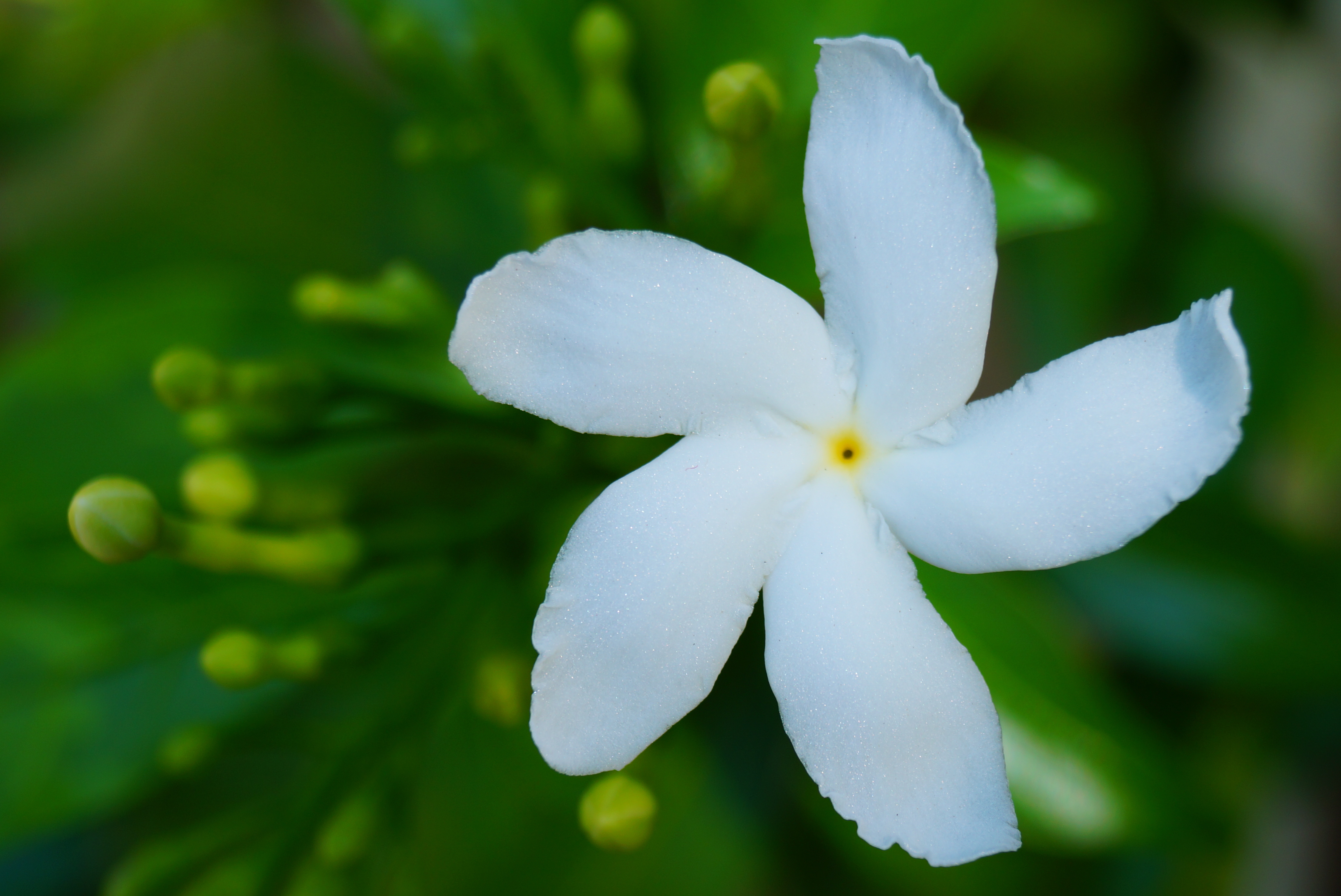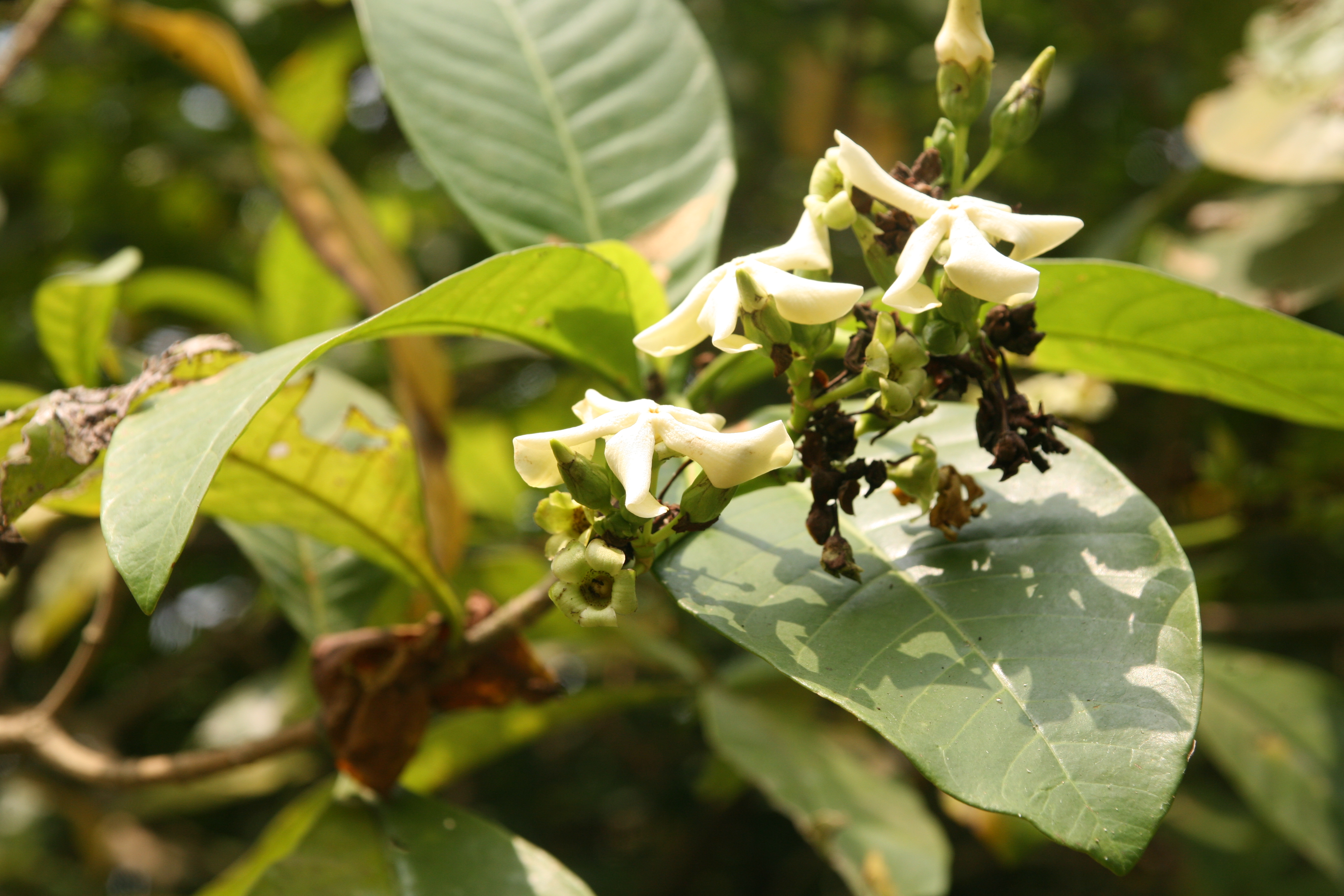|
Dregamine
Dregamine is a naturally occurring monoterpene indole alkaloid found in several species in the genus ''Tabernaemontana'' including '' Ervatamia hirta'' and ''Tabernaemontana divaricata''. History Dregamine was first reported in 1959 after its isolation from the apocynaceae '' Voacanga dregei'' (wild frangipani), a native small tree of southern Africa. The indole alkaloid tabernaemontanine is a closely related structure, differing only in the configuration of the ethyl group in the piperidine ring. Both structures are reduced versions of vobasine. There was confusion in the original literature regarding the configuration of the ethyl group in these molecules, so that their identities had been reversed. Synthesis Biosynthesis As with other Indole alkaloids, the biosynthesis of dregamine starts from the amino acid tryptophan. This is converted into strictosidine before further elaboration. Chemical synthesis Tryptophan was used as the starting material for a synthesis of dregamine. It ... [...More Info...] [...Related Items...] OR: [Wikipedia] [Google] [Baidu] |
Tabernaemontanine
Tabernaemontanine is a naturally occurring monoterpene indole alkaloid found in several species in the genus ''Tabernaemontana'' including ''Tabernaemontana divaricata''. History Tabernaemontanine was first reported in 1939 but its structure was only fully confirmed in the 1970s as there was confusion in the original literature regarding the configuration of the ethyl group in the piperidine ring of this alkaloid and its isomer dregamine, so that their identities had been reversed. Both compounds were isolated from plants of the dogbane (Apocynaceae) family including '' Tabernaemontana coronaria''. They have structures that are reduced versions of vobasine. Biosynthesis As with other Indole alkaloids, the biosynthesis of tabernaemontanine starts from the amino acid tryptophan. This is converted into strictosidine before further elaboration. Natural occurrence Tabernaemontanine is found commonly in the genera ''Tabernaemontana'' and ''Kopsia'', including the species '' Ervatamia h ... [...More Info...] [...Related Items...] OR: [Wikipedia] [Google] [Baidu] |
Vobasine
Vobasine is a naturally occurring monoterpene indole alkaloid found in several species in the genus ''Tabernaemontana'' including ''Tabernaemontana divaricata''. History Vobasine was first reported by Renner in 1959 after its isolation from ''Voacanga africana''. The two structurally related compounds, dregamine and tabernaemontanine, where its alkene (=CHCH3) sidechain was reduced to ethyl groups in two configurations, had their relationship confirmed in the 1970s. Vobasine has been found in many plants of the dogbane (Apocynaceae) family including '' Tabernaemontana dichotoma''. Synthesis Biosynthesis As with other Indole alkaloids, the biosynthesis of vobasine starts from the amino acid tryptophan. This is converted into strictosidine before further elaboration. Chemical synthesis The synthesis of alkaloids with the same carbon skeleton as vobasine began in the 1960s and has continued, with some work providing enantiospecific approaches to closely-related compounds. Natur ... [...More Info...] [...Related Items...] OR: [Wikipedia] [Google] [Baidu] |
Tabernaemontana Divaricata
''Tabernaemontana divaricata'', commonly called pinwheel flower, crape jasmine, East India rosebay, and Nero's crown, is an evergreen shrub or small tree native to South Asia, Southeast Asia and China. In zones where it is not hardy it is grown as a house/glasshouse plant for its attractive flowers and foliage. The stem exudes a milky latex when broken, whence the name milk flower. Description The plant generally grows to a height of and is dichotomously branched. The large shiny leaves are deep green and about in length and in width. The waxy blossoms are found in small clusters on the stem tips. The (single) flowers have the characteristic 'pinwheel' shape also seen in other genera in the family Apocynaceae such as ''Vinca'' and ''Nerium''. Both single and double-flowered forms are cultivated, the flowers of both forms being white. The plant blooms in spring but flowers appear sporadically all year. The flowers have a pleasing fragrance. More than 66 alkaloids are found in ... [...More Info...] [...Related Items...] OR: [Wikipedia] [Google] [Baidu] |
Catharanthine
Catharanthine is a terpene indole alkaloid produced by the medicinal plant ''Catharanthus roseus'' and '' Tabernaemontana divaricata''. Catharanthine is derived from strictosidine, but the exact mechanism by which this happens is currently unknown. Catharanthine is one of the two precursors that form vinblastine, the other being vindoline. Pharmacology (+)-Catharanthine competitively inhibits α9α10 nAChRs with potencies higher than that at α3β4 and α4β2 nAChRs and directly blocks CaV2.2. Catharanthine alkaloids are non competitive antagonist of muscle type nAChRs and this is thought to be the case due to presence of catharanthine moiety in those compounds. In ''in vitro'' study, it increased the levels of cAMP by inhibiting cAMP phosphodiesterase in brain. It is a potent inhibitor of TRPM8, similar to BCTC. Structural analysis of catharanthine shows activity on TRPM8, TRPA1, and butyrylcholinesterase. See also * Akuammicine * Conopharyngine * Stemmadenine St ... [...More Info...] [...Related Items...] OR: [Wikipedia] [Google] [Baidu] |
Genera
Genus ( plural genera ) is a taxonomic rank used in the biological classification of living and fossil organisms as well as viruses. In the hierarchy of biological classification, genus comes above species and below family. In binomial nomenclature, the genus name forms the first part of the binomial species name for each species within the genus. :E.g. ''Panthera leo'' (lion) and ''Panthera onca'' (jaguar) are two species within the genus '' Panthera''. ''Panthera'' is a genus within the family Felidae. The composition of a genus is determined by taxonomists. The standards for genus classification are not strictly codified, so different authorities often produce different classifications for genera. There are some general practices used, however, including the idea that a newly defined genus should fulfill these three criteria to be descriptively useful: # monophyly – all descendants of an ancestral taxon are grouped together (i.e. phylogenetic analysis should clearly demons ... [...More Info...] [...Related Items...] OR: [Wikipedia] [Google] [Baidu] |
Voacanga
''Voacanga'' is a genus of plants in the family Apocynaceae found in Africa, Southeast Asia, New Guinea, and Australia. the World Checklist of Selected Plant Families recognises 13 species:Search for "Voacanga", ;Species # ''Voacanga africana'' Stapf ex Scott-Elliot - tropical W + C + E + S Africa # ''Voacanga bracteata'' Stapf - tropical W + C Africa # ''Voacanga caudiflora'' Stapf - tropical W Africa # ''Voacanga chalotiana'' Pierre ex Stapf - tropical C Africa # ''Voacanga foetida'' ( Blume) Rolfe -Java, Borneo, Sumatra, Philippines # ''Voacanga globosa'' (Blanco) Merr. - Philippines # ''Voacanga gracilipes'' (Miq.) Markgr. - Maluku # ''Voacanga grandifolia'' (Miq.) Rolfe - Indonesia, Philippines, New Guinea, Queensland # ''Voacanga havilandii'' Ridl. - Sarawak # ''Voacanga megacarpa'' Merr. - Philippines # ''Voacanga pachyceras'' Leeuwenb. - Zaïre # ''Voacanga psilocalyx'' Pierre ex Stapf - Nigeria, Cameroon, Gabon, Republic of Congo # ''Voacanga thouarsii'' Roem. & S ... [...More Info...] [...Related Items...] OR: [Wikipedia] [Google] [Baidu] |
Ervatamia Malaccensis
''Tabernaemontana pauciflora'' is a species of plant in the family Apocynaceae. Description It grows as a shrub or small tree up to tall, with a trunk diameter of up to . The bark is pale grey to grey-brown. Inflorescences bear up to 15 flowers. The fragrant flowers feature white, sometimes yellow-throated, corolla lobes. The fruit is orange or yellow with paired follicles, up to in diameter. Name The specific epithet ' is Latin for "few-flowered".D. Gledhill ''Tabernaemontana pauciflora'' is native to Burma, Thailand, Cambodia, Vietnam, Borneo, Peninsular Malaysia, Singapore, Java and Sumatra Sumatra is one of the Sunda Islands of western Indonesia. It is the largest island that is fully within Indonesian territory, as well as the sixth-largest island in the world at 473,481 km2 (182,812 mi.2), not including adjacent i .... References pauciflora Plants described in 1826 Flora of Indo-China Flora of Malesia {{Apocynaceae-stub ... [...More Info...] [...Related Items...] OR: [Wikipedia] [Google] [Baidu] |
Monoterpene
Monoterpenes are a class of terpenes that consist of two isoprene units and have the molecular formula C10H16. Monoterpenes may be linear (acyclic) or contain rings (monocyclic and bicyclic). Modified terpenes, such as those containing oxygen functionality or missing a methyl group, are called monoterpenoids. Monoterpenes and monoterpenoids are diverse. They have relevance to the pharmaceutical, cosmetic, agricultural, and food industries. Biosynthesis Monoterpenes are derived biosynthetically from units of isopentenyl pyrophosphate, which is formed from acetyl-CoA via the intermediacy of mevalonic acid in the HMG-CoA reductase pathway. An alternative, unrelated biosynthesis pathway of IPP is known in some bacterial groups and the plastids of plants, the so-called MEP-(2-methyl-D-erythritol-4-phosphate) pathway, which is initiated from C5 sugars. In both pathways, IPP is isomerized to DMAPP by the enzyme isopentenyl pyrophosphate isomerase. Geranyl pyrophosphate is the precurso ... [...More Info...] [...Related Items...] OR: [Wikipedia] [Google] [Baidu] |
Ibogamine
Ibogamine is an anti-convulsant, anti-addictive, CNS stimulant alkaloid found in ''Tabernanthe iboga'' and Crepe Jasmine (''Tabernaemontana divaricata''). Basic research related to how addiction affects the brain has used this chemical. Ibogamine persistently reduced the self-administration of cocaine and morphine in rats. The same study found that ibogamine (40 mg/kg) and coronaridine (40 mg/kg) did not produce "any tremor effects in rats that differ significantly from saline control". While the related alkaloids ibogaine (20–40 mg/kg), harmaline (10–40 mg/kg) and desethylcoronaridine (10–40 mg/kg) were "obviously tremorgenic". Chemistry Synthesis Ibogamine can be prepared from one-step demethoxycarbonylation process through coronaridine. Pharmacology Like ibogaine, it has seems to have similar pharmacology. It has effects on KOR, NMDAR, nAChR and serotonin sites. It also inhibits acetylcholinesterase and butyrylcholinesterase See also ... [...More Info...] [...Related Items...] OR: [Wikipedia] [Google] [Baidu] |
Chiral Center
In stereochemistry, a stereocenter of a molecule is an atom (center), axis or plane that is the focus of stereoisomerism; that is, when having at least three different groups bound to the stereocenter, interchanging any two different groups creates a new stereoisomer. Stereocenters are also referred to as stereogenic centers. A stereocenter is geometrically defined as a point (location) in a molecule; a stereocenter is usually but not always a specific atom, often carbon. Stereocenters can exist on chiral or achiral molecules; stereocenters can contain single bonds or double bonds. The number of hypothetical stereoisomers can be predicted by using 2''n'', with ''n'' being the number of tetrahedral stereocenters; however, exceptions such as meso compounds can reduce the prediction to below the expected 2''n''. Chirality centers are a type of stereocenter with four different substituent groups; chirality centers are a specific subset of stereocenters because they can only hav ... [...More Info...] [...Related Items...] OR: [Wikipedia] [Google] [Baidu] |
Voacristine
Voacristine is a indole alkaloid occurring in ''Voacanga'' and ''Tabernaemontana'' genus. It is also an iboga type alkaloid. Chemistry Its structure is almost similar to voacangine, an alkaloid used in semi-synthesis of ibogaine. Compared to voacangine, it has an extra O-atom. When it is degraded, iboxygaine and ibogaine are formed. Sources Voacristine is found in multiple species of ''Tabernaemontana'' some of which are Tabernaemontana divaricata, Tabernaemontana heyneana, Tabernaemontana ventricosa and in Voacanga africana. See also * Heyneanine * Voacamine * Vobasine Vobasine is a naturally occurring monoterpene indole alkaloid found in several species in the genus ''Tabernaemontana'' including ''Tabernaemontana divaricata''. History Vobasine was first reported by Renner in 1959 after its isolation from ''Voac ... References Tryptamine alkaloids {{Alkaloid-stub ... [...More Info...] [...Related Items...] OR: [Wikipedia] [Google] [Baidu] |



